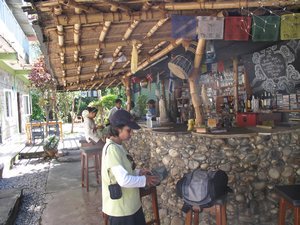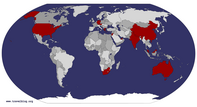Advertisement
Published: October 23rd 2009

 At Lalith's restaurant in Pokara
At Lalith's restaurant in Pokara
Lalith is Vivek's friend and is also from Darjeeling. Their band plays on Friday's. Pretty cool placeWhen we told Rindi that some friends of ours had trekked the Himalayas, she was very excited. The trek was going to be the highlight of her visit to India and Nepal. She had a lot of ground to cover in India. So our trek was just 3 days. It was a wonderful experience and I highly recommend it. We reached a maximum height of 2100 meters. Our route: Nayapul, Ghandrung, Landruk, Devrali and Phedi. We saw Annapurna south, Hinchuli and Fish tail on our trek.
BTW, Rindi is ecstatic because she has discovered the secret after 62 years. Men in Nepal and India could not keep their hands off Rindi. She says she will let you in on the secret for a small fee.
Things to remember next time if trekking in lower elevations of Nepal:
* Get a trekking pole - this really helped my back on the way down. Knee braces helped as well
* Get a sleeping bag liner. Very useful to put over the bed at night.
* Water proof pants and a rain jacket are important
* Do the right type of exercise to condition yourself - you will be climbing up and
down a lot of steep steps
* Pack for all kinds of weather - sun, rain, cold. We were fortunate since we had very good weather. It only rained one day when we were at lunch.
* Pack as light as you can. I kept wondering how our porter who probably weighed 120 lbs himself was going to carry both our bags.
* Get a torch especially if you end up trekking at night. This should not happen too often. It happened to us and it was an interesting experience. It was getting dark and we kept going. People were stopping us along the way and asking us why we were trekking at night. There weren't people around for long stretches. Most of the time I didn't know what I was stepping on. The kicker was when we asked Vivek, our guide, if he had trekked at night and his reply was "No". He had trekked for 2 years in Nepal and not trekked once at night. It didn't help when he said there were bears and mountain lions in the jungle. AHHHH!!!
* If possible, go with a group that is not trying to beat a record unless you
are trying to beat a record yourself. It was just Rindi and I with the guide and porter. So we took our time and enjoyed the views and they were breathtaking
* If going to Nepal, carry 25$ for the visa fee if you are not a SAARC country citizen
* Contact Vivek (viveklimbu08@gmail.com) to be your guide. Dhanapathi was a local porter with good enough English and he told us about many of the local customs. Vivek is from Darjeeling. I was surprised to hear that they learn Nepali in school there.
* We were told that it is important to eat muesli for breakfast, rice (carbohydrates) for lunch. Dal Bhat was the staple meal of our porter and guide. So it must be good for you on a trek!! Ask for the Nepali equivalent of Mudde made from millet. Also try the local wine at the end of the day. Ginger roasted in fire is good for cough
* Ask for Tomato Achar at Ram Lodge in Tolka. This was the best meal I had on the trip.
* Do not try Yak cheese. For one thing, yaks are male. Naks are the females that produce milk. Naks
are only available at higher elevations. So anything we get on the Annapurna trek is probably not really N(Y)ak cheese.
* Take some chocolates for the kids - Cadbury's Eclairs (this a popular candy on the sub continent not a pastry) works for Vivek and the kids. Children will ask you for sweets along the way. You will also get stopped by groups singing trekking songs trying to raise money for "school books". There was a very persistent girl that wanted me to hand out sweets or money to her. She took my hiking poles and would not give it back until I gave her something (I didn't have money or sweets at that point). I wouldn't have given it to her even if I did. This was only an isolated incident and should not happen very often
* Only INR up to 100 Rs are accepted in Nepal. Take a lot of 100 Re notes.
* Don't forget your ATM pin or card. Most places in Pokhara do not take cards or charge an exorbitant CC rate if they do
* Be warned that there will be many cute, sweet children along the way who walk to school an
hour each way on these steep mountains. Take time to talk to them and hand them sweets. You will remember them for a long time afterwords. At one point, we saw 2 brothers walking back from school. The older brother was teaching the younger one multiplication tables. They were repeating "Two five za" which is actually the local version of "Two five is a". We held a piece of Eclairs for the little one and asked him what the answer of "Two five za" was. He ran away without taking the Eclairs. He was not going to answer that question for an Eclairs chocolate!!!
* Take that picture when you have a clear view. We had a beautiful view from Ghandrung one morning. I turned around for a few seconds. When I turned back, there were clouds and the beautiful view of the mountains (Fist tail or Machapuchre, Annapurna South, Hinchuli) was no longer
* We seemed to have the best views early in the morning.
* Con-way move over! The mules have arrived. I understand the term "work like a donkey" now. They are a very important part of life on the mountains since they carry rations up and
down the mountains. I was amazed at how much weight they can carry. They are sure footed as well. I have new respect for mules now. All the traffic jams and rush-hour traffic were caused only by these mules. There is the issue of pollution as well. Their dung is used as manure.
* Stay away from nettle. They will sting. Rindi touched some by mistake. A local woman immediately walked over and applied some herbs on it. Although it didn't heal immediately, it got better soon. Locals drink soup made from nettle.
* Stay clear of marijuana as well or if you are so inclined.... It grows by the wayside.
* Make way for the porters. It is amazing how much weight men, women and children carry on their forehead - most of them wearing flip-flops. Some trekkers we met in Ghandrung told us they saw a man carry a full size refrigerator up the mountain.
* There are leeches along the way. Our guide got bitten by one and was not alarmed when it bled for a long time after that. It was all bad blood leaving the body he said.
* "Cheeeeeeeeeeso pani" is cold water and
"Thaaatho pani" is hot water
* Water is available all along the way. They reuse the bottle, not recycle. So we were told not to crush the bottle. At the base of the mountains, they do recycle.
* If you meet trekkers along the way wearing Oregon State T-shirts, do not ask them if they are from Oregon. One trekker we met, didn't know he was wearing an Oregon State T-Shirt. He was from Holland. Must have bought it at a red tag sale!!
Other observations:
* Kids help their parents with household chores after trekking 2 hours to school everyday
* They grow rice, wheat and millet. Soybean is grown along the edges of the crops
* Nepal's national animal is the cow, national flower is the rhododendron and the national bird, I cannot pronounce. April is another great time to go to the mountains since this is the time when the rhododendrons are in full bloom and the mountains look like they are on fire.
* I was amazed by the infrastructure available in these remote villages on the mountains. They have running water (of course) and electricity (sometimes generated by the villagers themselves)
* Moths come
out at night and butterflies during the day. There are male and female marigolds??
* There was mica everywhere along the way
* The fastest growing tree in the world grows in the sub tropical forests here at lower elevations - Almus Nepalinesis or Almus Sikkimisia.
* We saw a group of people building schools in the area. We were told that a lot of students come from UK to do NGO work here to work on schools, teaching locals about gardening and conservation etc.
* Locals mostly use herbal medicine. When they are really sick, they are carried by a porter to a hospital - the local ambulance.
* A lot of seeme badane (squash) is grown here.
* Sunday is the first day of the week. They work 6 days a week and are only off on Saturdays.
* Bamboo baskets are used for everything from carrying things up and down the mountain to garbage bags.
Advertisement
Tot: 0.099s; Tpl: 0.013s; cc: 11; qc: 45; dbt: 0.0615s; 1; m:domysql w:travelblog (10.17.0.13); sld: 1;
; mem: 1.2mb























amitha
non-member comment
Awesome
looks like a once in a lifetime experience ... gorgeous plc such sclusion to be away from the madness of concrete jungle... nice to get back to yourself once in a while n one with nature ....